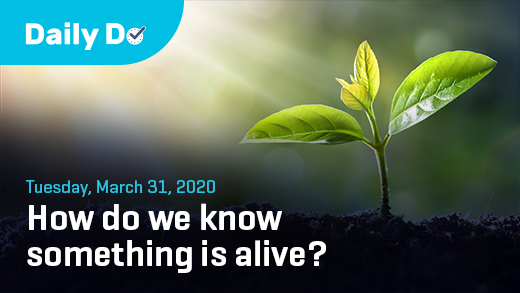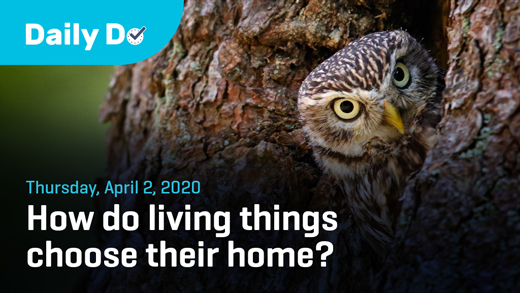Reflecting on this week’s Daily Do
By Korei Martin
Posted on 2020-04-03
Disclaimer: The views expressed in this blog post are those of the author(s) and do not necessarily reflect the official position of the National Science Teaching Association (NSTA).

With another week of home and distance learning behind us, it’s time to take a reflective look back and a hopeful – perhaps even excited – look forward. We shared in last week’s blog how crucial it is to give our students something to figure out if we want them to engage in science learning outside of the classroom. This week, let’s consider what it means to do science.
Making sense of the word – sensemaking – is the fundamental goal of science. The way students-as-scientists (and engineers) figure out how the world works is through the science and engineering practices. The actual doing of science or engineering can also pique students’ curiosity, capture their interest, and motivate their continued study; the insights thus gained help them recognize that the work of scientists and engineers is a creative endeavor—one that has deeply affected the world they live in. (A Framework for K-12 Science Education, p 42).
Next week, we’ll choose a science and engineering practice to highlight and offer a vignette that describes what students engaging in that practice to figure out a phenomenon might look like in home and distance learning.
Below you’ll find descriptions of every Daily Do published this week. As you visit each Daily Do or reflect on one you taught during the week, look for evidence the task provides students opportunities for sensemaking. Can you identify what students are trying to figure out (phenomenon)? Can you point to instructions/guidance that describe how students are figuring it out (science and engineering practices)? Go one step further – follow the link to the science and engineering practices and identify a specific practice students use to engage in figuring out a phenomenon. How might this inform the design of your own at-a-distance teaching and learning?
Monday, March 30, 2020 – Why does population size change?

In today’s task, Why does population size change?, students engage in science and engineering practices and use the lens of cause and effect (crosscutting concept) to figure out there is a maximum number of buffalo an area can support based on the living and nonliving components of the ecosystem. This task has been modified from its original design to be used by high school students, families, and teachers in distance and home learning. While students could complete this task independently, we encourage students to work virtually with peers or in the home with family members.
Tuesday, March 31, 2020 –How do we know something is alive?

One of the big ideas in life science young students need opportunities to make sense of is animals and plants use their external (outside) and internal (inside) parts to get what they need to grow and survive. (They also use those parts to avoid what they don’t need – like being eaten by someone else!)
Today’s task, How do we know if something is alive?, utilizes children’s books and family reading time to invite students to share and build on their ideas about things that are alive and things that are not. Wonderings about living things and what they have in common leads students to engage in science and engineering practices to figure out that living things grow and move. This task is modified from the elementary lesson,”Do You Know Which Ones Will Grow?”, published in Even More Picture-Perfect Science Lessons: Using Children’s Books to Guide Inquiry, K-5. The series of Picture Perfect books was developed to help K-5 teachers integrate science and reading in an engaging, kid-friendly way. The strategies for reading aloud to support students’ sense-making in science can be used at multiple grade levels with any scientific concept.
Wednesday, April 1, 2020 –How do we cross bodies of water?

Today’s Daily Do presents two different – but related – science tasks centered around children’s books.
- What Floats in a Moat? (K-2) Students float and sink everyday objects to figure out what makes somethings float and other things sink.
- Who Sank the Boat? (3-5) Using aluminum foil and pennies, students figure out how the shape of a boat and it’s ability to float are related through an engineering design challenge.
Although designed for different grade levels, you may choose to do both tasks with your K-5 students (you can adjust the amount of scaffolding in both tasks). Make sure to check out the STEM careers at the end of this Daily Do – Naval Architecture and Marine Engineering!
Thursday, April 2, 2020 –How do living things choose their home?

Topic: Habitats
Today’s task is inspired by the NSTA eBook Home is Where My Habitat Is. The story follows a jumping spider named Kippy in her search for a new place to live. Though her habitat is small, some of the animals that Kippy encounters live in much larger ones. Diversity doesn’t exist just in the types of plants and animals living in a habitat; Kippy journeys through many different types of habitats as well.
In this task, How do living things find a home?, students and their families read the NSTA eBook Home is Where My Habitat Is and use the thinking tools of patterns and cause and effect (crosscutting concepts) to make sense of the science idea animals live in habitats and changes in habitats affects the animals living there. Opportunities to make connections between local habitats and the habitats Kippy encounters inspire appreciation and stewardship of habitats around the world as well as close to home.

Friday, April 3, 2020 –Where do new infectious diseases come from?
Today’s task, Where do new infectious diseases come from?, creates an opportunity for students to look at examples of infectious diseases they might know a lot about and compare them to diseases they want to know more about. Students engage in science and engineering practices – including the use of a simulation (mathematical model) – to figure out how “new” infectious disease-causing bacteria can come from bacteria that have been around for awhile.
This task has been modified from its original design in order to be used by students, parents, and teachers in distance and home learning. While students could complete this task independently, we encourage students to work virtually with peers or in the home with family members.


